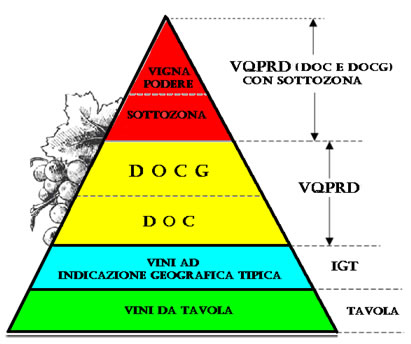ITALIAN APPELLATION SYSTEM
Italy's classification system has four classes of wine, with two falling under
the EU category "QUALITY WINE PRODUCED IN A SPECIFIC REGION" (QWPSR) and two
falling under the category of "TABLE WINE". The four classes are:
TABLE WINE:
"VINO DA TAVOLA" (VDT) - Denotes simply that the wine is made in Italy, the
label usually indicates a basic wine and is mostly made for local consumption.
"INDICAZIONE GEOGRAFICA TIPICA" (IGT) - Denoteswine from a more specific region
within Italy. This appellation was created in 1992 for wines that were
considered to be of higher quality than simple table wines, but which did not
conform to the strict wine laws for their region.
Before the IGT was created
SUPER TUSCAN wines such as TIGNANELLO were labeled as table wines. Nowdays many
of these IGT wines from all Italian Region to surclass in quality and making
politically protected wines with DOC or DOCG denominations.
QWPSR or in Italian VQPRD:
"DENOMINAZIONE DI ORIGINE CONTROLLATA "(DOC) and
"DENOMINAZIONE DI ORIGINE CONTROLLATA E GARANTITA" (DOCG)
Both DOC and DOCG wines refer to zones which are more specific than IGT, and the
permitted grapes are also more specifically defined. The DOC system began in
1963, seeking to establish a method both recognizing quality product and
maintaining the international and national reputation of that product. The main
difference between a DOC and a DOCG is that the latter must pass a blind taste
test for quality in addition to conforming to the strict legal requirements to
be designated as a wine from the area in question. After the sweeping wine laws
of 1992, transperent rules were made regarding requirements for DOCG entry,
impsing new limits regarding the production of grapes per hectare and minimum
natural alcohol levels, among others.
Further delimitations are the Sub-zones (CRU) which can go to identify a single
vineyard..
